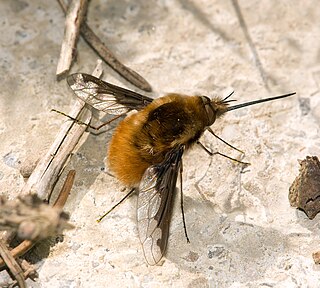
The Bombyliidae are a family of flies, commonly known as bee flies. Adults generally feed on nectar and pollen, some being important pollinators. Larvae are mostly parasitoids of other insects.

Anthrax is a genus of bombyliid flies, commonly known as "bee-flies" due to their resemblance to bees. Most are dull black flies, and are usually small to medium in size, 4–20 millimetres (0.2–0.8 in), and many species have striking wing patterns.

The Asiloidea comprise a very large superfamily insects in the order Diptera, the true flies. It has a cosmopolitan distribution, occurring worldwide. It includes the family Bombyliidae, the bee flies, which are parasitoids, and the Asilidae, the robber flies, which are predators of other insects.
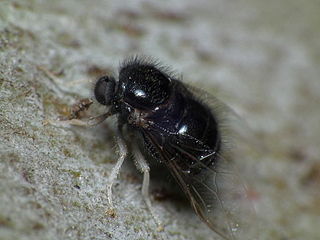
The Acroceridae are a small family of odd-looking flies. They have a hump-backed appearance with a strikingly small head, generally with a long proboscis for accessing nectar. They are rare and not widely known. The most frequently applied common names are small-headed flies or hunch-back flies. Many are bee or wasp mimics. Because they are parasitoids of spiders, they also are sometimes known as spider flies.

Bombylius major is a parasitic bee mimic fly. B. major is the most common type of fly within the Bombylius genus. The fly derives its name from its close resemblance to bumblebees and are often mistaken for them.

Balaana is a genus of flies belonging to the family Bombyliidae (bee-flies). There are about seven described species, including three from western Australia. These are robust and very hairy flies with a body length of 10–18 mm (0.4–0.7 in).
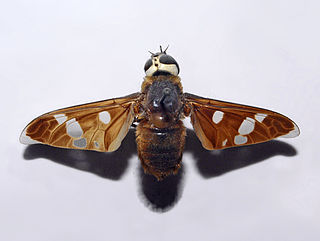
Hyperalonia is a genus of bee flies in the family Bombyliidae.

Bombylius canescens, is a species of bee-fly belonging to the family Bombyliidae.
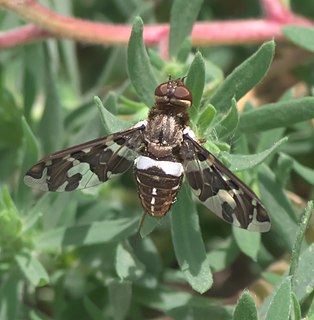
Exoprosopini is a tribe of bee flies in the family Bombyliidae. There are more than 20 genera and 760 described species in Exoprosopini.
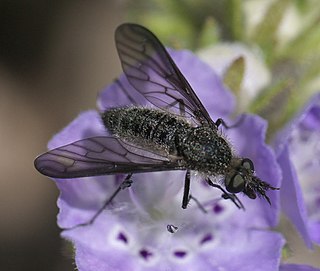
Bombyliinae is a subfamily of bee flies in the family Bombyliidae. There are more than 70 genera in Bombyliinae.

Eclimini is a tribe of bee flies in the family Bombyliidae. This tribe was formerly considered a subfamily of Bombyliidae, but was transferred to the subfamily Bombyliinae as a result of research published in 2019.

Brachyanax is a genus of bee fly in the subfamily Anthracinae. It was circumscribed by Neal Evenhuis in 1981. Thirteen species are recognized, and they are found in Asia and Australasia.

Villini is a tribe of bee flies in the family Bombyliidae.

Systoechus is a genus of bee flies in the family Bombyliidae. There are more than 120 described species in Systoechus.

Aphoebantini is a tribe of bee flies in the family Bombyliidae. There are about 5 genera and at least 80 described species in Aphoebantini.
Diochanthrax is a genus of bee flies in the family Bombyliidae. There is one described species in Diochanthrax, D. morulus.

Xenox is a genus of bee flies. There are five described species in Xenox, all of which parasitize bees in the genus Xylocopa as larvae.
Heterotropus is a genus of bee flies in the family Bombyliidae. It is the only genus in the subfamily Heterotropinae, which formerly contained at least four genera. There are more than 45 species in the genus Heterotropus.
Crocidiinae is a subfamily of bee flies in the family Bombyliidae. There are about 8 genera and 50 described species in Crocidiinae.

Lordotinae is a small subfamily of bee flies in the family Bombyliidae. This subfamily was formerly considered a tribe of Bombyliinae, but was elevated to subfamily as a result of research published in 2019.
















